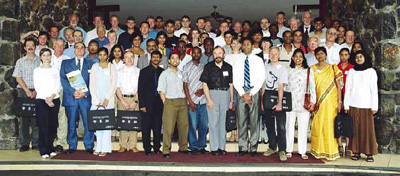|
|
Vol.
28 No. 2
March-April 2006
Polymers
for Africa
by
Dhanjay Jhurry
The 8th
UNESCO School and IUPAC Conference on Macromolecules
was held in Mauritius in June 2005, and for the first time
since its inception, the meeting took place outside South
Africa. It was a great honor for the Mauritian organizers
to have been given the opportunity to host this meeting and
also a great challenge to achieve the high level set in the
past by Professor Ron Sanderson and his team at Stellenbosch
University.
The meeting started with a two-day UNESCO School on 4–5
June 2005 held at the University of Mauritius. The School
was officially opened on 4 June 2005 by Dr. M.S. Alam, director,
Division of Basic & Engineering Sciences, UNESCO, Paris.
The UNESCO School aims at capacity building in existing and
emerging areas in polymer science and technology through training
of undergraduate/graduate students and young researchers.
An important innovation brought to the UNESCO School was the
organization of lectures both in English and French, the first
setup of this kind in the world.
Eight lectures were delivered covering a wide range of topics
in polymer science, including biopolymers, biodegradable polymers,
and polysaccharides, all of which are of prime interest to
the region vis-àvis sustainable development: Professor
Michel Vert, “Biodegradable Polymers”; Professor
Robert Gilbert, “Polysaccharides: Molecular Weights
in Synthetic and Natural Polymers”; Dr. Daniela Held,
“Polymer Characterization: Size-Exclusion Chromatography”;
Professor Goerg Michler, “Polymer Characterization:
Electron Microscopy Techniques”; Professor Helmut Ritter,
“Functionalized Polymers: Synthesis and Modification”;
Professor Henri Cramail, “Coordination Polymerization:
Ziegler-Natta/Metallocenes”; Dr. Bert Klumperman, “Polymer
Synthesis: Living Free-radical Polymerization”; and
Professor Axel Müller, “Polymer Synthesis: Living
Anionic Polymerization.”
All lectures have been compiled on a CD-ROM available free
of charge to all 50 participants. The enthusiasm of both lecturers
and students and their hard work during the weekend was highly
commendable and contributed to the success
of this first event.
The IUPAC Conference was held 6–9 June 2005 at the La
Pirogue Hotel, Flic en Flac, Mauritius. The first day of the
conference started with the opening ceremony in the presence
of University of Mauritius officials and other distinguished
guests. UNESCO and IUPAC were represented by Dr. M.S. Alam
and Professor R. Gilbert, respectively.
 |
| Participants
at the 8th UNESCO/IUPAC Conference on Macromolecules.
Front row, center right, wearing a tie is Professor Dhanjay
Jhurry, and on his right is Professor Jean Fréchet. |
The
IUPAC Conference was attended by approximately 100 participants,
including 70 from 17 foreign countries. Participants included
high-caliber polymer scientists as well as young researchers
and postgraduate students. Major objectives of the conference
included providing young scientists of the region a forum
for presenting their research work, providing networking opportunities,
and fostering research collaborations between the north and
the south.
The conference featured five plenary lectures, 27 invited
lectures, 15 contributed papers, and 30 poster presentations
covering the following five major themes in polymer science
and frontier areas of particular interest to the greater African
region (Africa and Indian Ocean island states):
•
biopolymers/biodegradable polymers/polysaccharides
• polymers in food and textile
• polymers in health and medicine
• functional polymers
• new emerging materials and characterization techniques
The
enthusiastic participation of numerous young graduate students
and scientists led to many lively discussions during the well-attended
poster sessions. Eighteen papers presented at the IUPAC Conference
have been collected in a special volume of Macromolecular
Symposia entitled "Polymers
for Africa" (Vol 231, 2006; ISBN 3-527-31334-6).
In the preface of that volume, Professor Jean Fréchet
writes:
"It
is obvious that this conference series can make an important
contribution to the development of polymer science in the
African continent as more young scientists are exposed to
and participate in state-of-the-art polymer research in
contexts of relevance to their local environment. While
it is clear that holding such conferences on the African
continent stimulates the all-important participation of
both young and more mature African scientists, should the
rest of the world not be exposed to the needs and issues
of polymer science in the developing world? Should topics
such as “Polymers for Africa” or “Polymers
for the Developing World” be included in the major
IUPAC sponsored polymer conferences held in the developed
world to sensitize polymer scientists to the special needs
of developing nations? It is hoped that the readers will
be stimulated to attend and participate in the next edition
of the “Polymers for Africa” conference for
a better understanding of the global significance of this
topic."
It
is undeniable that the organization of such meetings in countries
far from the major centers of education and research can contribute
to the development of polymer science and help lay the groundwork
for future economic development in those countries and regions.
Professor Gilbert wrote: “Because of the excellent organization,
the relaxed atmosphere and the high quality of invited speakers,
this was one of the most fruitful conferences I have ever
attended.” Sponsors included the University of Mauritius,
UNESCO, IUPAC, ACU, the French Embassy in Mauritius, TWAS,
and the Tertiary Education Commission (Mauritius).
Dhanjay
Jhurry <[email protected]>
is associate professor and head of the Department of Chemistry
at the University of Mauritius in Réduit. He was chairman
of the local organizing committee.
Page
last modified 10 August 2006.
Copyright © 2003-2006 International Union of Pure and
Applied Chemistry.
Questions regarding the website, please contact [email protected]
|